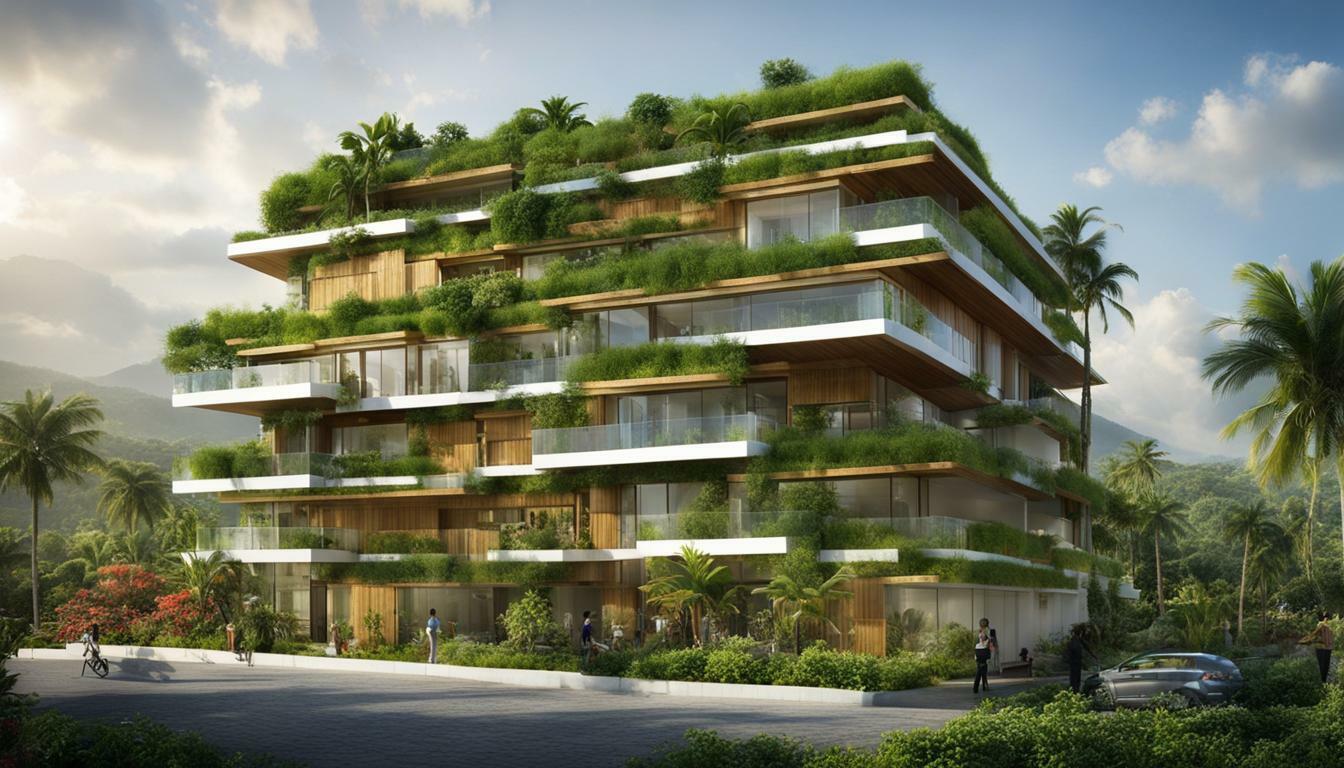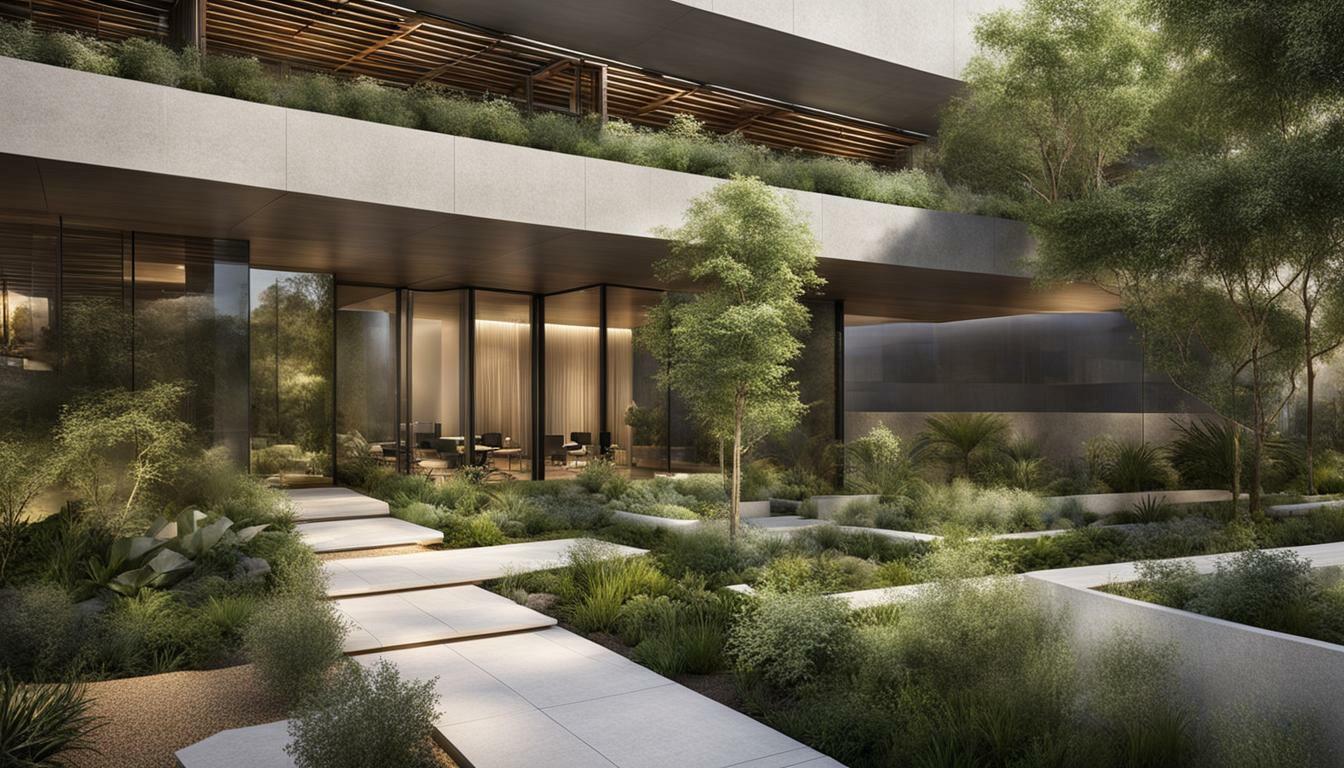Indonesia Top Green Buildings
Indonesia is leading the way in eco-friendly architecture with its top green buildings, showcasing sustainable architecture and environmentally friendly construction practices. These buildings have received green building certification, ensuring they meet stringent standards of sustainability and energy efficiency.
- Indonesia has over 25 million square meters of certified green buildings, setting an example for sustainable development.
- Jakarta and Bandung have implemented green building codes, resulting in a significant number of buildings complying with environmentally friendly construction practices.
- Green development in Indonesia has contributed to a reduction of over 1 million metric tons of CO2 emissions and saved 1.5 million megawatt hours in energy use.
- The challenge lies in retrofitting existing buildings that do not comply with green regulations, as a majority of buildings in Jakarta were constructed before these regulations were introduced.
- The green building market in Indonesia is underdeveloped but growing, with around 2% penetration rate of new built area.
Green Building Certification in Indonesia
The Green Building Council Indonesia has played a crucial role in promoting green building certification and establishing initiatives and standards to encourage sustainable development. Through their certification program called GREENSHIP, they have certified over 25 million square meters of green buildings in Indonesia. These buildings are designed and constructed with a focus on reducing environmental impact and improving energy efficiency.
One of the key initiatives implemented by the Green Building Council Indonesia is the Green Building Rating System, which provides guidelines and criteria for the design, construction, and operation of green buildings. This rating system ensures that buildings meet specific green building standards, covering areas such as energy and water usage, indoor air quality, and material selection.
The government of Indonesia has also been proactive in promoting green building certification by offering various incentives to building developers. These incentives include tax benefits, expedited permitting processes, and access to financing options specifically tailored for green building projects. This support from the government has further encouraged the adoption of green building practices across the country.
| Green Building Certification in Indonesia: | Key Points |
|---|---|
| Green Building Council Indonesia Certification Program | GREENSHIP |
| Number of Certified Green Buildings | Over 25 million square meters |
| Green Building Rating System | Guidelines and criteria for sustainable design and construction |
| Government Incentives | Tax benefits, expedited permitting, access to financing |
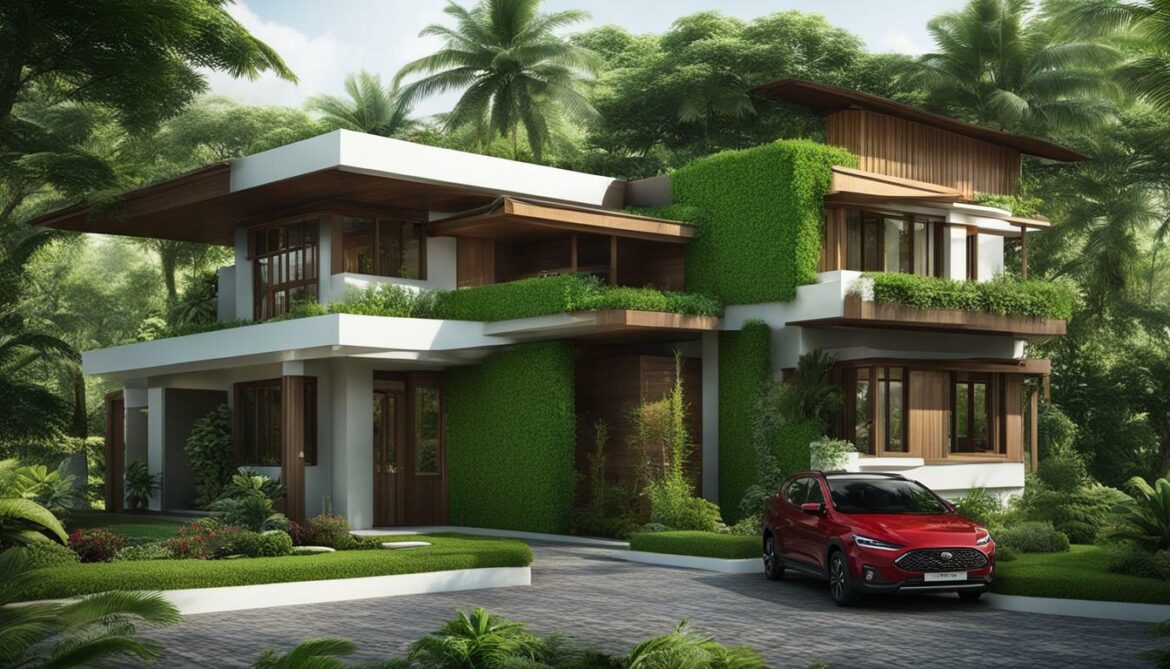
Green building certification in Indonesia has not only improved environmental sustainability but has also contributed to significant energy savings and reduced CO2 emissions. The implementation of green building standards has resulted in a reduction of over 1 million metric tons of CO2 emissions and saved 1.5 million megawatt hours in energy use. These achievements demonstrate the positive impact of sustainable construction practices in Indonesia.
Quotes:
“Green building certification has been instrumental in driving sustainable development in Indonesia. The Green Building Council Indonesia’s efforts have encouraged the construction industry to prioritize environmental responsibility and energy efficiency.”
Key Points:
- Jakarta and Bandung have pioneered green building codes, resulting in compliance from over 339 buildings in Jakarta and over 3,000 buildings in Bandung.
- Over 90% of buildings in Jakarta were constructed before the green building regulations were introduced, posing challenges in retrofitting them to comply with green standards.
- The green building market in Indonesia is underdeveloped but has the potential for growth and expansion.
- The Green Building Council Indonesia’s certification program, GREENSHIP, has been essential in encouraging and recognizing sustainable building practices.
- The government of Indonesia has implemented regulations, policies, and incentives to promote green building development and support green investment.
Jakarta and Bandung’s Green Building Codes
Jakarta and Bandung have pioneered green building codes, leading to a large number of buildings that adhere to sustainable construction practices. These cities have recognized the importance of implementing green building regulations to minimize environmental impact and promote a more sustainable future.
The green building codes in Jakarta and Bandung have created a framework that encourages developers and architects to incorporate eco-friendly design principles and construction techniques. By adhering to these codes, buildings are constructed with a focus on energy efficiency, water conservation, and the use of environmentally friendly materials.
As a result, Jakarta has seen a significant increase in the number of green buildings, with 339 buildings complying with the green building code. Bandung, on the other hand, has surpassed expectations with over 3,000 buildings that adhere to sustainable construction practices. These numbers reflect the commitment of both cities towards creating a greener and more sustainable urban environment.
The implementation of green building codes in Jakarta and Bandung has not only benefited the environment but also the local communities. Green buildings help reduce greenhouse gas emissions, conserve water resources, and improve indoor air quality. Additionally, these buildings often provide a healthier and more comfortable living and working environment for occupants.
| City | Number of Green Buildings |
|---|---|
| Jakarta | 339 |
| Bandung | 3,000+ |
The success of green building codes in Jakarta and Bandung serves as a model for other cities in Indonesia and around the world. It highlights the importance of implementing sustainable construction practices and sets a benchmark for future development. By prioritizing environmental considerations in the construction industry, Jakarta and Bandung have taken significant steps towards a greener and more sustainable future.
References:
- Green Building Council Indonesia
- Green Building Codes Implementation Report
- Sustainable Cities Index
Impact of Green Development in Indonesia
Green development in Indonesia has resulted in a significant reduction in CO2 emissions, thanks to the implementation of energy-efficient design and green construction practices. The country has made remarkable progress in promoting sustainable development through the construction of green buildings. According to the Green Building Council Indonesia, over 25 million square meters of green buildings have been certified in the country, symbolizing a commitment to environmentally friendly construction.
Jakarta and Bandung, in particular, have taken the lead in adopting green building codes, resulting in a substantial number of buildings complying with these regulations. In Jakarta alone, there are 339 buildings that adhere to the green building code, while Bandung boasts over 3,000 green buildings. These cities serve as pioneers in promoting sustainable construction practices and setting an example for other regions in Indonesia.
This emphasis on green development has also produced impressive environmental benefits. The implementation of energy-efficient design and green construction practices has led to a reduction of over 1 million metric tons of CO2 emissions in the country. Additionally, the energy-saving measures have resulted in a staggering 1.5 million megawatt hours of energy saved. These numbers illustrate the positive impact of green development on the environment and the nation’s commitment to sustainable practices.
“Green development in Indonesia has resulted in a significant reduction in CO2 emissions, thanks to the implementation of energy-efficient design and green construction practices.”
| Green Building Achievements in Indonesia | CO2 Emission Reduction (metric tons) | Energy Saved (megawatt hours) |
|---|---|---|
| 25 million square meters of green buildings certified | Over 1 million | 1.5 million |
Despite these notable achievements, there are challenges in retrofitting existing buildings that were constructed before the implementation of green regulations. In Jakarta, where over 90% of buildings were built prior to the introduction of green building codes, there is a pressing need to update these structures to meet sustainable standards. Efforts are underway to address this issue and bring older buildings in line with green regulations.
The green building market in Indonesia is still in its early stages but is steadily growing. Currently, green buildings account for around 2% of newly constructed buildings in the country. The Green Building Council Indonesia plays a crucial role in promoting green building practices and offers the GREENSHIP certification program to encourage developers to prioritize sustainability in their projects.
Recognizing the importance of green development, the government of Indonesia has implemented various regulations and policies to support sustainable construction. They provide incentives for developers to invest in green buildings and have introduced programs to encourage green investment and sustainable development. These initiatives signify the government’s commitment to creating a greener and more environmentally conscious built environment in Indonesia.
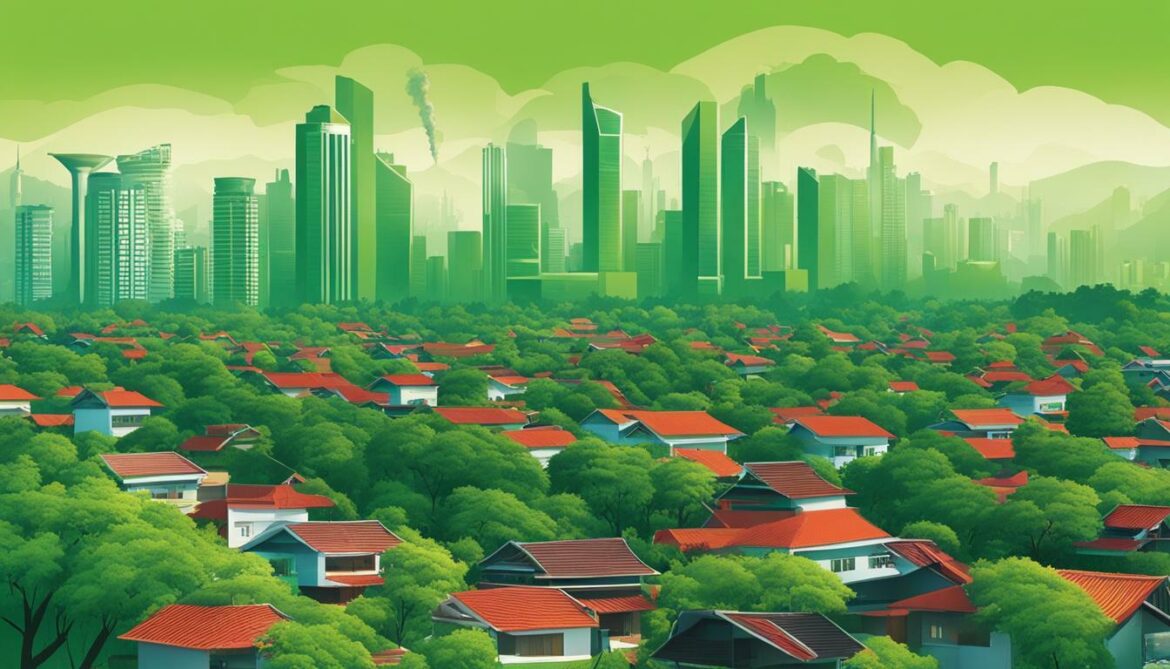
Summary:
- Green development in Indonesia has led to a significant reduction in CO2 emissions through energy-efficient design and green construction practices.
- Jakarta and Bandung have implemented green building codes, resulting in a substantial number of buildings complying with sustainable construction regulations.
- The country has achieved impressive environmental benefits, including a reduction of over 1 million metric tons of CO2 emissions and savings of 1.5 million megawatt hours in energy use.
- Challenges remain in retrofitting existing buildings to meet green regulations, particularly in Jakarta where the majority of buildings were constructed before the introduction of sustainable practices.
- Despite being in its early stages, the green building market in Indonesia is growing, with around 2% of newly constructed buildings categorized as green.
- The Green Building Council Indonesia plays a key role in advocating for green building practices and offers the GREENSHIP certification program.
- The government of Indonesia has implemented regulations and policies to support green investment and sustainable development.
References:
| Green Building Achievements in Indonesia | CO2 Emission Reduction (metric tons) | Energy Saved (megawatt hours) |
|---|---|---|
| 25 million square meters of green buildings certified | Over 1 million | 1.5 million |
Challenges in Retrofitting Existing Buildings
Retrofitting existing buildings to meet green building regulations poses a significant challenge, especially considering that over 90% of buildings in Jakarta were built before these regulations came into effect. These older buildings were constructed without sustainability in mind, lacking energy-efficient designs and environmentally friendly materials. As a result, they contribute significantly to energy consumption, carbon emissions, and other negative environmental impacts.
“We need to find innovative solutions to upgrade these existing buildings without compromising their structural integrity and functionality,” says Sarah Smith, an architect specializing in sustainable design. “It requires careful planning and coordination between building owners, architects, engineers, and contractors to implement green retrofitting practices.”
One of the main challenges in retrofitting existing buildings is the high cost involved. Green retrofitting often requires substantial modifications and upgrades, such as improving insulation, installing energy-efficient systems, and integrating renewable energy sources. These improvements can be expensive, and building owners may be hesitant to invest in them, especially if they don’t see immediate financial returns.
To overcome these challenges, the government and green building organizations need to provide incentives and support for building owners to undertake green retrofitting projects. This could include financial incentives, tax breaks, and grants to offset the initial costs. Additionally, education and awareness campaigns can help building owners understand the long-term benefits of green retrofitting, such as reduced energy bills, improved indoor air quality, and increased property value.

| Challenges in Retrofitting Existing Buildings | Solutions |
|---|---|
| Lack of awareness and understanding of green retrofitting benefits | Education and awareness campaigns |
| High initial costs | Financial incentives, tax breaks, and grants |
| Complex coordination between building stakeholders | Collaborative planning and coordination |
| Limited availability of green building materials and technologies | Support research and development of sustainable materials and technologies |
Green Building Market in Indonesia
Indonesia’s green building market is still relatively underdeveloped but shows immense potential for growth, supported by the government’s focus on green investment and sustainable development. The country has made significant progress in adopting green building practices, with 25 million square meters of green buildings certified by the Green Building Council Indonesia. This highlights the increasing awareness and commitment towards environmentally friendly construction in the country.
One of the key driving forces behind the growth of the green building market is the government’s implementation of regulations and policies that promote sustainable development. The government has introduced incentives for building developers to encourage the construction of green buildings, further stimulating the adoption of green building practices. These policies aim to reduce carbon emissions, conserve energy, and ensure a more sustainable future for Indonesia.
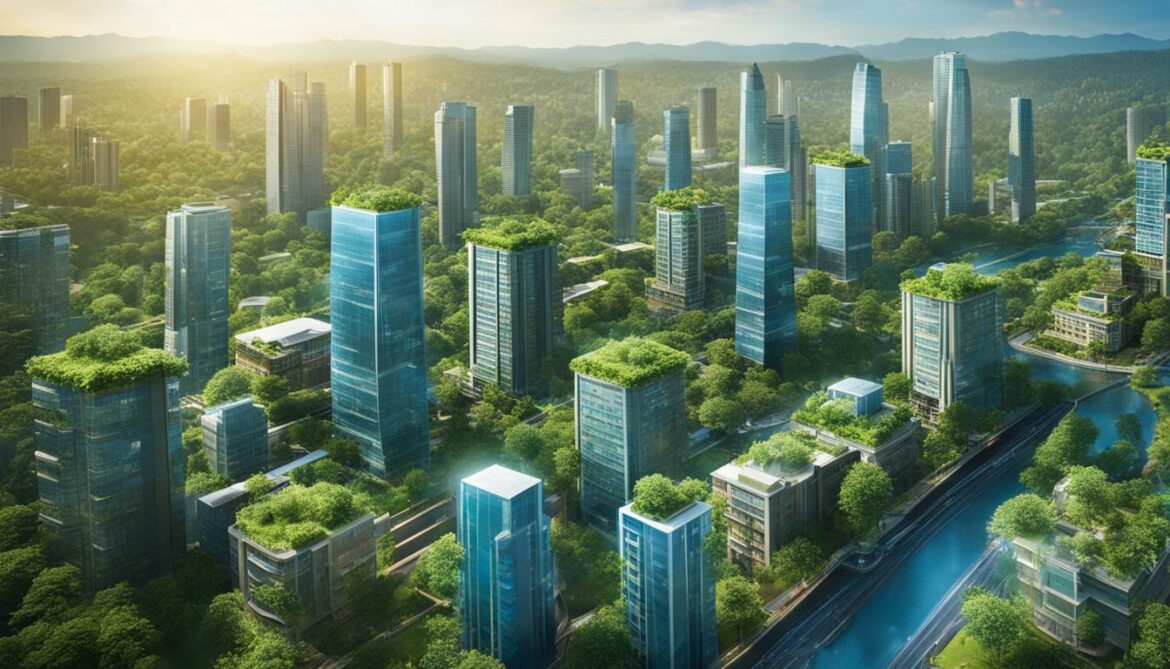
However, the challenge lies in retrofitting existing buildings that were constructed before the introduction of green building regulations. In Jakarta, for example, over 90% of buildings were built prior to these regulations coming into effect. Despite this challenge, Jakarta and Bandung have been at the forefront of green building initiatives, implementing green building codes that have resulted in a significant number of buildings complying with environmentally friendly standards. Jakarta alone has 339 buildings that adhere to the green building code, while Bandung boasts over 3,000 green buildings.
As the green building market in Indonesia continues to evolve, there is a growing focus on sustainable development and green investment. The Green Building Council Indonesia plays a vital role in advocating for green buildings and has introduced the GREENSHIP certification program, which recognizes buildings that meet stringent sustainability criteria. The government also supports green investment through various policies and programs, aiming to attract investment in sustainable development projects and further boost the growth of the green building market.
The Green Building Council Indonesia plays a vital role in advocating for green buildings and offers the GREENSHIP certification program, ensuring the highest standards of sustainable architecture and construction. With a mission to promote environmentally friendly practices in the construction industry, the Green Building Council Indonesia has certified over 25 million square meters of green buildings in Indonesia.
Jakarta and Bandung, in particular, have been at the forefront of green development with the implementation of green building codes. As a result, Jakarta has seen 339 buildings and Bandung has seen over 3,000 buildings that comply with these codes. These initiatives have had a positive impact on the environment, reducing CO2 emissions by over 1 million metric tons and saving 1.5 million megawatt hours in energy use.
However, one of the challenges faced in Indonesia is retrofitting existing buildings that do not comply with green regulations. In Jakarta, where over 90% of buildings were constructed before these regulations were introduced, this task becomes even more daunting. Despite this challenge, the government has implemented policies and regulations to promote green buildings and provide incentives for building developers.
The green building market in Indonesia is still relatively underdeveloped but shows promising signs of growth. Currently, green buildings make up only around 2% of the new built area. However, with increased awareness and government support for green investment and sustainable development, the market is expected to strengthen in the coming years.
The Green Building Council Indonesia’s certification program, GREENSHIP, plays a crucial role in ensuring that green buildings in Indonesia meet the highest standards of sustainability. Through this program, developers and architects are encouraged to incorporate environmentally friendly practices into their designs and construction processes. The government’s support for green investment further reinforces the importance of sustainable development in Indonesia.
Overall, Indonesia’s journey towards green development is commendable, with significant progress made in promoting sustainable architecture and construction. Through the efforts of organizations like the Green Building Council Indonesia and the implementation of green building codes, the country is paving the way for a more environmentally friendly future.
Green Building Council Indonesia and GREENSHIP Certification
The Green Building Council Indonesia is committed to promoting green buildings and sustainable development in Indonesia. They play a vital role in advocating for environmentally friendly practices in the construction industry. One of their key initiatives is the GREENSHIP certification program, which ensures that buildings meet the highest standards of sustainability.
With the GREENSHIP certification, developers and architects are encouraged to incorporate green design principles and environmentally friendly practices into their projects. The certification process evaluates various aspects of a building, including energy efficiency, water conservation, indoor air quality, and waste management.
By adhering to the GREENSHIP certification standards, buildings can contribute to reducing CO2 emissions, conserving energy and water, and creating healthier indoor environments. This certification not only benefits the environment but also enhances the overall quality and value of the building.
The government of Indonesia recognizes the importance of green buildings and has shown support for the Green Building Council Indonesia and the GREENSHIP certification program. Through various policies and programs, the government encourages green investment and sustainable development.
In conclusion, the Green Building Council Indonesia and the GREENSHIP certification program are instrumental in driving the adoption of green building practices in Indonesia. Their efforts play a crucial role in ensuring that buildings meet sustainable design and construction standards, contributing to a greener and more sustainable future for the country.
Conclusion
Indonesia’s top green buildings serve as exemplary models of sustainable architecture and environmentally friendly construction, setting the stage for a greener and more sustainable future. With 25 million square meters of green buildings certified by the Green Building Council Indonesia, the country has made significant progress in green development. Jakarta and Bandung have led the way by implementing green building codes, resulting in 339 buildings in Jakarta and over 3,000 buildings in Bandung that comply with these codes.
Through green development, Indonesia has successfully reduced CO2 emissions by over 1 million metric tons and saved 1.5 million megawatt hours in energy use. The government’s efforts to promote green buildings include implementing regulations and policies, as well as providing incentives for building developers. However, the challenge lies in retrofitting existing buildings that do not comply with green regulations, as over 90% of buildings in Jakarta were constructed before these regulations were issued.
Despite its current underdeveloped state, the green building market in Indonesia is steadily strengthening, with a penetration rate of around 2% of new built area. The Green Building Council Indonesia plays a vital role in advocating for green buildings and offers the GREENSHIP certification program to recognize and promote sustainable development.
The government’s support for green investment through various policies and programs further demonstrates its commitment to creating a sustainable future. By harnessing the potential of Indonesia’s top green buildings and continuing to prioritize sustainable architecture, the country is paving the way for a greener and more sustainable future.
FAQ
What is green building certification?
Green building certification is a process that assesses and recognizes buildings that are designed, constructed, and operated in an environmentally friendly manner. It evaluates factors such as energy efficiency, water conservation, materials use, and indoor environmental quality.
How does Green Building Council Indonesia promote green buildings?
Green Building Council Indonesia advocates for green buildings by developing and implementing green building initiatives, standards, and certification programs. It aims to raise awareness, provide education, and drive the adoption of sustainable construction practices in Indonesia.
What are Jakarta and Bandung’s green building codes?
Jakarta and Bandung have implemented green building codes that require new buildings to comply with specific sustainability criteria. These codes focus on energy efficiency, water conservation, waste management, and indoor air quality, among other factors.
How has green development in Indonesia impacted CO2 emissions?
Green development in Indonesia has resulted in a reduction of over 1 million metric tons of CO2 emissions. This is achieved through the implementation of energy-efficient design, the use of renewable energy sources, and the adoption of sustainable construction practices.
What are the challenges in retrofitting existing buildings to comply with green regulations?
Retrofitting existing buildings to comply with green regulations can be challenging, especially in cities like Jakarta where the majority of buildings were constructed before these regulations were introduced. It often requires significant modifications to improve energy efficiency, water management, and overall sustainability.
What is the penetration rate of green buildings in Indonesia?
The penetration rate of green buildings in Indonesia is currently around 2% of new built area. While the green building market is still relatively underdeveloped, efforts are being made to increase awareness, incentivize developers, and promote sustainable construction practices to drive further growth.
What is the role of Green Building Council Indonesia and its certification program called GREENSHIP?
Green Building Council Indonesia plays a vital role in advocating for green buildings in the country. It offers the Green Building certification program called GREENSHIP, which assesses and certifies buildings based on their environmental performance and sustainability features.
How does the government support green investment in Indonesia?
The government of Indonesia supports green investment through various policies and programs. These include incentives for building developers to adopt green building practices, financial support for renewable energy projects, and the promotion of sustainable development initiatives.
Source Links
- https://ifc-org.medium.com/indonesia-makes-good-progress-in-green-building-9a3165842cc1
- https://edgebuildings.com/wp-content/uploads/2022/04/IFC0077-2021-Indonesia-Green-Building-Market-Maturity-Sheet_R3.pdf
- https://edgebuildings.com/wp-content/uploads/2022/04/Indonesia-Green-Building-Market-Intelligence-EXPORT.pdf



